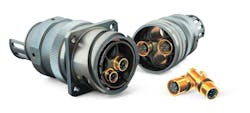Three Connector Technologies Building the Future of Rail
Families on holiday, busy commuters, and hardworking train operators all want the same thing: a seamless rail experience between Point A and Point B.
The good news is that modern connector technologies are helping to make that easier than ever. Here are three connector technologies and innovations transforming the rail experience for passengers and operators alike.
High-Speed Ethernet Connectivity
As the digital revolution marches on, people are increasingly expecting the same level of connectivity they enjoy at home in every aspect of their lives. The train is no exception.
As a result, more trains are beginning to integrate Ethernet technology to provide a better, more comfortable transit experience for passengers. Some leading global train manufacturers are also taking advantage of Ethernet technology’s unlimited network length, reliability and speed to supplement legacy WTB/MVB systems in many on-board applications.
The reason? The existing Train Communication Network (TCN) standard for data communication can’t keep up with the industry’s accelerating demand for higher bandwidth requirements. The TCN standard is a hierarchical combination of two fieldbus systems: a wire train bus (WTB), which connects equipment within a vehicle, and a multifunction vehicle bus (MVB), which connects between vehicles. It was originally adapted because of its low cost, reliability, immunity to message collision and short recovery time. But it wasn’t built for high levels of data connectivity.
As a result, WTB/MVB systems are being overwhelmed by a proliferation of new sensors, on-board processing and other electronic systems. And, as passenger data needs continue to grow due to smart-device usage, this shortcoming will become even more apparent.
Eventually, Ethernet will replace WTB/MVB systems entirely, carrying all data types needed for control, security and passenger information, from announcements to propulsion and lighting. But for now, the industry is equally reliant on both modern and legacy systems.
Ideally, that means your connectors need to support both. M12 Ethernet connectors are an ideal connector solution, in particular ones that support both standard TCN and high-speed Ethernet communication. This ensures you can keep up with increasing bandwidth needs and deliver an enjoyable passenger experience while still supporting TCN so you don’t disrupt your current operations. And they make it easier to smoothly and cost-effectively transition to full Ethernet when the time comes.
High-Performance, Sustainable Plating
The environmental challenges of rail are older than rail itself. The challenges in protecting connectors that run between rail cars from the elements and ensuring consistent performance, however, are constantly evolving.
Most metal connectors are made of aluminum because it’s light, low-cost, available and easy to machine. To increase connector lifespan, reduce repairs, and keep trains up and running, connector manufacturers coat them with a protective plating that helps them withstand harsh conditions. But today’s environmental regulations — specifically RoHS and REACH — make accomplishing this formerly routine procedure more complex.
With expectations on the rise, you can’t afford components that don’t perform when you need them. You need plating treatments that strike the perfect balance between durability and sustainability. Treatments that are completely RoHS and REACH compliant, but robust enough to prevent corrosion and ensure solid connector performance day after day.
Luckily, leading component companies have you covered. Some of the best modern connector platings blend zinc and nickel to achieve incredibly long life without harming the environment through the use of hazardous chemicals. With these platings, you get upward of 500 hours of salt spray resistance, as well as high connectivity and shielding performance. They can also withstand temperatures from -55°C to +125°C.
Bottom line: They can handle just about any harsh environment you’ll come across in rail.
Compact, Lightweight Connectors
Better sensors, smoother functions, increased connectivity — more features and advanced technology usually mean a more pleasant experience for passengers and operators alike. But as train manufacturers develop more complex, feature-rich trains, they’re running into challenges with space and weight. Simply put, space is limited on train cars. So engineers need to get creative and figure out how to fit a lot in a finite amount of space.
For this reason, connectors that can pack a lot of performance and reliability into a lightweight, compact package are becoming even more important to the rail market.
Innovative connector companies are pushing the boundaries of what’s possible in a limited footprint. By consolidating multiple contacts into the same compact connector, you can reduce your total number of connectors and free more space.
The Future of Rail Can Be Seen Now
So what’s the takeaway? The rail market is accelerating. It’s only going to get more connected, sustainable and modular going forward. Old products and practices are no longer enough to keep up with rising expectations. So, if you want to provide a next-level rail experience for operators and passengers, now is the time to get on board with the next generation of high-performance connector technologies.
--------
George Blazas is the North American Rail Market manager at ITT Veam and Cannon
